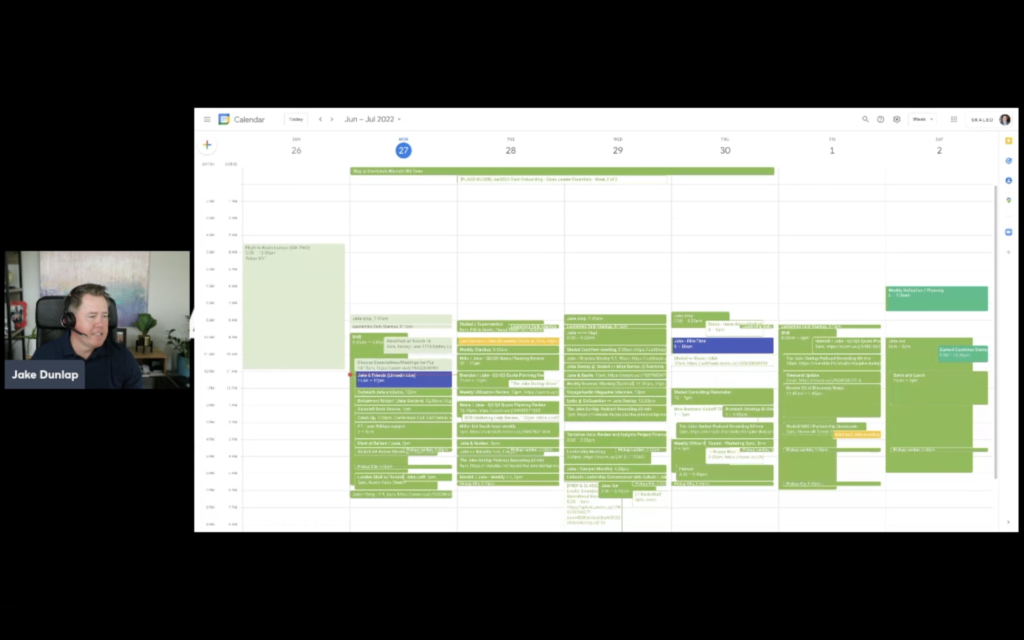
Three Tips for Being More Productive (& Less Stressed) as a VP or CRO
Jake Dunlap
There are a few things I’ve changed in my patterns over my career that have made a significant impact on how productive I am and have eliminated as much stress as possible.
From a sales leader to VP to CEO, what I cover in this live session is less about quick tips and hacks for time management, but how I’ve constructed my work life, what worked and what didn’t, and how it’s all shaped today so I can focus on what matters most.
If you’re looking for more real-life examples and how this plays out in the day-to-day, watch the 30-minute recording. But if you just want the main productivity tips, check out the recap below.
Recap: My 3 Tips for Being More Productive (& Less Stressed) as a VP or CRO
At different points in my career, working at a larger company or startup environment, I’ve had to handle different levels or types of stress.
At CareerBuilder, I was able to go into a new leadership role and have a long-term mindset. I was new to the role but already had a team that I needed to reassess, had my set priorities, had my goals, and had nine months to turn it around, and again, this was at a large company.
Fast forward four to five years and I took over as VP of Sales at Glassdoor. I had one guy I worked with before and brought with me, but that was it, and I needed to go and hire 40 people immediately.
This was a completely different kind of stress where I just needed to hire, hire, hire and didn’t have the same 6 to 12 to 24 month horizon mentality.
What I’m sharing today are the things that I do coming from both of these types of environments (and honestly, pretty applicable even if you’re not a VP or CRO).
Work-life balance is something many of us also strive for, but before I get into how I balance my time in work and life, I also want to point out that the best way to be more productive and less stressed is to come up with your own construct that works in the environment you’re in.
Here’s what I do, take my life lessons, tweak them if you need to, and if they work, great. Don’t force it.
I’ll start out with my anti-tip.
I read this book a few years ago called the 5:00 AM Club, and I was really into it until I realized that I like sleep. I tried it, though, for 44 days. I got up between 5:00 – 6:00 AM every day, and I was miserable. I hated it.
So all the productivity things I’m going to talk about that make me an effective leader and CEO, understand that it’s also about finding out what works for you.
Tip #1 – My calendar is how I run my life
I’ll give an example.
There are maybe 50 meetings or blocks on my calendar this week, even personal stuff, and some people find this stressful, but it’s the opposite.

I don’t like to sandwich three weeks of this many meetings back to back, and you’ll notice there are some lighter days, but for me, having it all in the calendar relieves stress because everything has a place, and I don’t just block out meetings, but internal work time as well.
Looking at it now may give you anxiety, but there’s a freedom to it. I very rarely wake up in the morning or the middle of the night and think, “Crap. I forgot about that.” My calendar takes care of it all.
But there is obviously still a lot going on, and I adjust it each week.
Here’s a sub-tip.
Tip #1b – Cancel or move meetings that don’t matter anymore
There have been multiple occasions, and it still happens, where I’ll have a meeting that was booked three weeks ago, and that thing is deprioritized, or covered in another meeting, or it just doesn’t matter anymore. So I remove it.
My calendar is how I digest and run what’s most important to me in the business at any given time, so I keep it flexible.
Tip #2 – Be an expert re-negotiator
Whether you’re a VP, CRO, CEO, or starting out as an SDR, we all say yes too much. I still say yes too much.
So for me, it’s not just practicing the art of “no” but how to renegotiate.
There are a couple of reasons why we all say yes. We get FOMO. We fear that we won’t be brought in on future projects if we say no to this one thing. We want to help people; it makes us feel good. And the most common one is fear of saying no because if someone asks, they obviously need you to do it.
Whatever the reason is, there are two ways to renegotiate.
You can renegotiate from the start before ever saying yes. And the easiest way to put it is, “Absolutely, more than happy to. I have this and this as a top priority for his week. What would you like me to move?”
That’s if you’re managing up.
The second way, and why this is important is because I always like to say don’t ever fail in a silo, is go back and renegotiate before your time is up. Don’t just sit on it and say you over-committed after the fact and not do it or rush and give C+ work.
If you’re mastering your calendar, you know what due dates you’ve committed to already. And if you’re looking at it a week or two from now and need more time, go back to the group immediately.
Here’s a real example of me doing this as a CEO. After our extended leadership meeting at the beginning of June, I committed to helping to reshape our meeting structure and schedule for our consulting leadership team. In reality, after the meeting and after I looked at my calendar, I knew that I realistically wasn’t going to get it done by the time I told the team. So I sent them a note and said, “Hey, the best time I can find to do this is here. I know it’s later than we planned, but I can guarantee to get it done by then.”
Everyone said sounds good. They knew when to expect it, and it would be done right. Otherwise, I would have rushed to jam it in, created sub-par work, and still may have been late.
This also leads me to another sub-tip.
Tip #2b – Start early with something small
I try to avoid renegotiating, and I don’t want to give you this tip and have it be something to always fall back on. What I do so I don’t have to renegotiate is start early with something small.
What I mean by that is if I can, I try to kick off a project early, even if it’s something small I can do, and even if I have weeks or two months to do it and spread it out over time.
We all have this in the back of our minds that we’re not going to wait until the last minute, and something happens. But if you’re putting it on the calendar (yes, tip #1 again), it’s easier to do this and make time.
Tip #3 – Don’t clutter your mind with things you can’t control
This is the hard one, especially if you’re a VP of Sales or CEO. There’s something new, good or bad, every single day. And when it feels the worst or most stressful is when you latch on to something that you can’t do anything about, or not right away.
Say it’s a Friday afternoon, and you think, “What am I going to do?” Nothing. Put it on the calendar for Monday.
You’ll see I’m going back to my very first tip again. Even though it looks cluttered, it’s a relief mechanism because everything has a home. I don’t have to clutter my mind with things I can’t control or don’t matter now. I can stay focused on the things I can do today, which will have a long, medium, or short-term impact, not the things I can’t control.
This tip is less tactical and more of a mindset, but I can tell you from leading hundreds and hundreds of people that trying to take on everyone’s burdens at all times, and trying to solve them in real-time, creates significant problems and is probably the most stressful.
I personally hate having stuff linger around me, but there’s no substitute for time. You just have to put certain things down that you can’t control at the moment. And this could be an employee issue, a client issue, or a project. You definitely can’t change behavior overnight, and the best thing to do is to stay the course and hope if you stay the course and invest in that person, relationship, or customer that things will work themselves out.
Looking at it as a work/life construct
If you look at these tips put together, this is the work construct I’ve created for myself and not just a few hacks or habits.
-
- I don’t have to worry about problems or get anxious that I’ve forgotten something because I have calendar time to tackle that problem. And I have a lot of projects and problems to deal with.
- When I do overcommit, and the plate overflows, I’ve learned the skill of renegotiation, and I can renegotiate ahead of time, so it’s not inconvenient for my team.
- And I don’t clutter my mind with things I can’t do anything about or control right now. I focus on what I can.
Again, you have to find a balance that works for you, but I’ll also leave you with that to find this balance, you have to think big picture. Whatever tactics you choose to use, they need to coalesce.